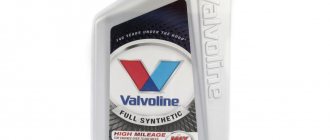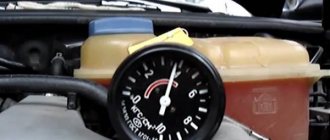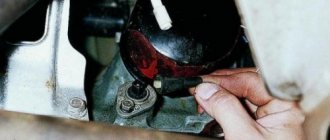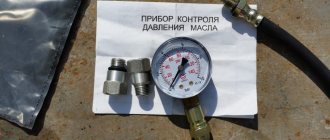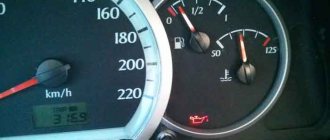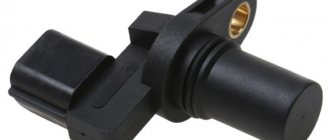There is one of the indicators on the dashboard of cars that informs the driver about a decrease in oil pressure in the engine unit. The so-called oil pressure light in the form of an oil can signals a critical condition of the engine - insufficient amount of lubricant. On the panels of VAZ “classic” cars (six, seven, nine) there is also such an indicator. And if it suddenly lights up while driving or at low speeds while parked, this is a signal that there is a malfunction in the engine.
Why does the oil pressure light come on in a VAZ classic?
The first step is to distinguish cases when an icon in the form of an oil can is suddenly displayed. It is completely safe for the icon to light up for just a few moments in the following cases:
- when there is a strong roll of the car on a sharp turn;
- when starting in winter;
- after a long period of parking on uneven ground.
As a rule, in such situations, oil flows from one part of the engine to another, which is why the oil pressure sensor is triggered. However, after some time, the working fluid is evenly distributed, and the signal about a drop in pressure in the system stops. The situation is similar when starting the engine unit in the cold season: at low temperatures, the working fluid thickens, accordingly, it is necessary to warm up the engine properly in order to create the necessary pressure in the system.
In all other cases, the appearance of an oil can on the instrument panel indicates the presence of failures or malfunctions. So for what reasons can the oil pressure light come on in classic VAZ models?
- First of all, due to a lack of oil in the engine.
- Due to an exhausted oil filter.
- The oil pressure sensor or its wiring is to blame.
- Wear of the liner on the crankshaft.
- The oil pump has failed.
Any of these reasons can affect the oil pressure level in the engine unit. Therefore, the car owner will first have to find the source of the problem and only then begin troubleshooting.
The oil level control device is located separately
This is interesting: How to increase engine power - truly effective ways
How far can you drive if the gas light comes on?
The table below provides approximate values for a particular car model
Please note that the data is provided for cars manufactured up to 2015 inclusive. Also keep in mind that some values in the table may differ slightly from actual values.
But on average the following values are obtained:
- Passenger cars, after the fuel level light in the tank lights up, can still travel about 50 kilometers.
- When SUVs and crossovers, which, as a rule, have an increased volume of fuel tanks, can travel about another 150 kilometers on a burning fuel light.
Does this mean that car owners may not rush to the gas station when they see a low fuel warning on their dashboard? Of course not. Especially if you are in an unfamiliar area and have no idea how far away the next gas station will be.
How does the oil sensor work and why can it fail?
Now let's consider the situation if you are on the road and the low pressure indicator has triggered.
The very first thing you need to do is stop the vehicle and turn off the engine. As soon as it cools down, you will have to check the lubricant level in the system. There is a special dipstick under the hood for this purpose. It is wiped dry and immersed in its original place. It is quite possible that the level will be below the minimum level. This means that somewhere there is a leak or depressurization of connections. You can set off again only after adding oil to the engine. If the lamp continues to light after starting and does not go out subsequently, it makes sense to think about towing the car to the nearest service station or to a trusted auto mechanic. The matter may turn out to be quite serious, so it is advisable to conduct the examination in a calm environment. Since we have already said that the causes of low pressure may be associated with a faulty sensor, it would be useful to understand the principle of operation of this device. There are certain contacts inside it. Until the ignition is turned on, there is no pressure in the system, so the contacts are closed. When you turn the key and turn on the ignition, but before the starter starts, the warning lamp should be on. If this does not happen, then there may be some kind of malfunction. Maybe the light bulb itself simply burned out, or maybe the contacts were broken or the sensor itself failed. As soon as we start the engine, the contacts open, leading to the light bulb going out.
Reasons for the indicator to light up
It should be noted that the oil pressure light may come on intermittently in some situations without presenting any danger to engine operation. Such situations include:
If the light comes on while driving or at idle, and does not go out after a while, then appropriate measures should be taken. The oil pressure indicator indicates the occurrence of failures and malfunctions. Such problems occur not only in the engine, but also in the electronic part. Some of the main reasons why this indicator lights up include:
In certain cases, it is necessary to stop and determine the presence of oil in the engine using a dipstick. If the level is normal, then you should get to the nearest station or home, and then determine the reason for the light coming on. If there is no oil, then continuing to move under your own power is strictly prohibited, because this may cause the motor to jam.
If the pressure indicator lights up, you should make an emergency stop and turn off the engine. After this, a number of steps should be taken to determine the cause of such consequences.
Checking the lubricant level
After stopping, you need to open the hood and remove the dipstick. The measuring scale of the dipstick should be wiped, then reinsert it into the hole, and then remove it and make sure there is a sufficient level of lubricant. If the dipstick shows a minimum fluid level, then you should top it up, but then try to find out the reasons for the decrease in level. Often the reason for a drop in oil level is its leakage through the seals, which need to be changed periodically.
After the oil is added to the engine, the indicator will not light up, which indicates that the cause has been correctly eliminated. Low oil pressure in the engine can also be determined using a special dial-type indicator, which displays information for the driver about the state of oil pressure. However, on VAZ 2107 cars such indicators are not installed from the factory, although some motorists install them themselves.
Oil filter malfunction
If the lubricant level is in order, then the cause of such consequences may be a faulty filter. If you recently changed the oil and filter, and after some time the light comes on, then there is a high probability that you have received a defective filter. Under such circumstances, you will need to replace not only the filter, but also the lubricant in the system. Such cases, although rare, are all appropriate.
Checking the health of the sensor
The malfunction may consist of a breakdown of the sensor itself or a short circuit in the supply wiring. To check the health of the sensor, there are two ways:
In the first case, the pressure in the system must be at least 0.35 kgf/cm2. The value on the pressure gauge is not lower than the specified one, indicating that the system is working properly and the sensor is faulty. In the second case, the test involves connecting the multimeter probes to the sensor terminals. In this case, the device should show zero resistance. Now you need to pump using the pump, as a result of which the multimeter readings should change and it will show infinity. In order to check the integrity of the wiring suitable for the sensor, you should test it using a multimeter. Replacing the sensor is not particularly difficult, so even a beginner can cope with this task.
Checking the quality of the lubricant
If all of the above methods have been tried, but the icon continues to light, then you should check the quality of the oil. To do this, you need to inspect the dipstick, with which you can easily determine the presence of signs of antifreeze or gasoline in the lubricant. To do this, you need to dip the dipstick in water and see if streaks appear on the surface, then the reason is that foreign liquid has entered the motor.
In such a situation, a complete flush of the engine, as well as major repairs, cannot be avoided. It is necessary to eliminate the cause of gasoline or antifreeze getting into the engine compartment.
From the above, it should be noted that in order to avoid unpleasant situations, when the oil pressure light comes on, you should immediately stop and find the cause.
Source
Special malfunctions of VAZ engines
These problems are common to almost all types of engines used in cars, including domestic ones.
POPULAR WITH READERS: Do valves bend on Renault Sandero?
But there are also specific faults that occur only on certain cars.
On classic models VAZ-2106, 2107, the pump is driven from the timing chain via a drive gear and a drive roller.
A common problem in the malfunction of the lubrication system is wear of the gear sector on the gear or shaft. Replacing these elements allows you to get rid of problems.
As for modern cars, from the VAZ-2108 to the VAZ-2115, they have a direct pump drive, from the crankshaft gear.
The absence of intermediate elements in the design has increased the reliability of the drive, so the problems that arise in the engines of classic VAZs do not occur in modern cars.
About additives and properties of oils for increasing pressure in the system
Some car enthusiasts are interested in whether there is motor oil that increases the pressure in the system. Rather, we are talking about special additives that improve its characteristics. The main result from the use of such compounds (for example, SUPROTEC) can be called the restoration of the previous parameters of operating processes in the engine. The surfaces of working parts and mechanisms of the piston group, worn out by constant friction, are partially restored, and their oil-holding capacity increases. As a result, fuel combustion efficiency increases and engine compression improves. Many oils contain special additives that are aimed at reducing engine lubricant consumption.
Sincerely, blog author Andrey Kulpanov
Place for contest advertising
Machine diagnostic procedure
There is a known homemade method that will help you find out if there are problems with blood pressure:
- Start the engine and warm up the car well (drive 5-6 km).
- Depress the brake and clutch at the same time.
- Engage the gear and gradually release the clutch (hold the brake).
- If the tachometer shows below 500 rpm and the lamp does not light up, the pressure is normal.
If there is a problem, you can look for the breakdown yourself. Then at the service center you will spend less time on diagnostics, pointing out to the mechanic the most likely cause of the malfunction. The check is carried out according to the following algorithm:
- Open the hood of the car and check for oil leaks. If they are, there is a leak in the system.
- Inspect the oil filter. If there are smudges, try tightening the part clockwise. Perhaps the problem will go away.
- Inspect the crankcase (located on the bottom) for leaks. If they are identified, you must urgently contact the service center, having first provided “first aid” - plug the gap using dry welding, fabric or a special rubber gasket.
You should start checking after the car has warmed up and stopped for ten minutes.
The battery does not hold a charge
If the voltage at the terminals is less than 12.5 Volts, remove the battery for charging. After charging the battery to 12.7 V, leave it unused for 12-24 hours. Then check the voltage at the terminals or the density of the electrolyte. A working battery will not be discharged during such a period. The cause of the discharge could lie in overloading of power supplies by consumers, frequent short trips, or frost. There is a possibility that the generator is malfunctioning.
Buying a new battery before you are sure that the old one is unsuitable is irrational. But if you have a spare one and the ability to use a battery from another car, you can install it in place of yours while it is charging, and try to start the car and drive it for several kilometers.
If the light on the VAZ panel no longer lights up, the problem was a discharged battery. We are waiting for ours to charge. If it does not hold a charge, we buy a new one or, if we have the time, desire, and abilities, we restore the old one.
Consequences of ignoring the problem
Stopping the engine when the pressure lamp lights up is a mandatory measure. Ignoring the signal can result in very serious problems:
- As a result of “oil starvation”, the contacting surfaces of components and mechanisms will begin to work “dry”, which will lead to their intense wear and high heating. If you take a crankshaft, the main and connecting rod bearings will begin to melt and “wrap” around the journals, which will lead to jamming of the crankshaft;
- Lack of lubrication will lead to intense wear of the camshaft “bed”;
- Wear products - small metal shavings - will spread through the channels of the lubrication system, which can lead to their clogging. Also, chips can cause jamming of the pressure relief valve and damage to the oil pump gears.
Elimination of such malfunctions is only possible through a major overhaul of the power plant.
Check the electrical
If the Check Engine light does not come on when you turn on the ignition (especially if the car has been sitting idle for a long time in a garage or on the street), then the problem may be quite trivial. And first of all, you should check the battery itself (it also happens that the lights on the dashboard are barely lit rather dimly, and the car itself does not respond to the key).
It is possible that the power supply is discharged, or the contacts have oxidized or a terminal has come loose (or, alternatively, the wires have broken). In general, first of all, we check the battery itself to make sure that power is being supplied and the current is flowing at the required strength.
Also, on the positive terminal of the battery there is a wire that is responsible for powering the ECM. Sometimes it happens that it is broken - you need to check it first.
If everything is in order, we proceed further.
We check the electrical systems of your car
. For example, relays and connectors near the electronic control unit, the wires themselves going to the ECU. Perhaps the on-board computer is malfunctioning (but without certain knowledge in this area, you most likely will not be able to determine this). By the way, it wouldn’t hurt to check the fuses that control the light bulbs and ignition. We take the diagram out of the glove compartment and find out which ones. If they are burnt, you need to change them urgently.
If, apart from the check, there are no other signs of life, then perhaps it’s time for the ignition switch itself. We check the lock, clean the wiring, the power should be supplied. We try to start again, and again there is no reaction, then the lock will most likely have to be changed.
If everything starts up fine, but the light does not light up when the key is turned 180, then perhaps the problem is in the light bulb itself. After all, it (although this happens quite rarely) can burn out - especially from high humidity and condensation in the car interior, formed for any reason. It is also quite easy to check with certain skills (you will need to disassemble the torpedo). Or perhaps the supply wire has become unsoldered or frayed and there is no contact.
If you have thoroughly checked everything and even at the same time eliminated some shortcomings in the systems of your car, and the “check” still does not light up when you turn on the ignition, then you will have to come to terms with the fact itself and take your car to a familiar electrician at the nearest service station. With the help of certain devices, he will accurately determine the cause of this malfunction. But you shouldn’t delay this, even if the check engine that doesn’t light up doesn’t interfere with your driving and the car doesn’t show any visible faults.
The reason for such an event may turn out to be more complex and serious, but why do you need unplanned repairs to the engine or other compartments?
- What to do if the “check” does not light up when you turn on the ignition
- 1. What is it responsible for and what does the “check” on the dashboard of a car mean?
- 2. Why the “check” does not light up when the ignition is turned on: we are looking for the cause of the malfunction.
- 3. How to troubleshoot problems with the check engine control unit?
Why does the oil pressure light come on at idle when the engine is warm?
Most Zhiguli owners are faced with the problem of indicating a drop in oil pressure at idle speed. There may be several reasons for this:
- malfunction in the oil pressure sensor;
- the oil pump is clogged or faulty;
- low-quality oil is poured;
- severe wear of the splines;
- a faulty oil filter is used.
Video: reasons for the oil pressure sensor to operate and troubleshooting methods
Thus, the pressure sensor signals the presence of problems in the engine unit. If the owner does not have the necessary experience in diagnostics and repair, then it is better to entrust the identification of the true cause of the problem to a specialist. In addition, when the oil can icon lights up, it is not recommended to drive the car - there is a high probability that the rubbing parts of the engine will jam. In this case, the motor will practically not be restored.
VAZ cars of classic models are equipped with outdated, but fully functional mechanisms. The same oil pressure sensor, which signals the driver about problems with the lubrication of engine elements, performs its functions quite successfully: at the right moment the device is activated, which allows the driver to take timely measures. The most important concern of the car owner should not be repair work, but preventive procedures. Only vigilant monitoring of the condition of the engine unit and the selection of proven working fluids and filters will allow you to delay costly major repairs as much as possible.
Copywriter, needlewoman, traveler
Home →
Maintenance and Repair →
Engine →
Purpose of the button
The instrument panel in a car is a way for the driver to monitor the level of gasoline, oil, engine operating condition or other components of the car, which guarantee comfortable and silent driving on the road.
Modern cars are equipped with an indicator necessary for the convenience and comfort of the driver. If earlier an engine malfunction had to be found only visually or by carefully listening to the operation, today a special light bulb works. It is created for the convenience of monitoring the engine condition. Ideally, it should light up only when the engine starts and go out after a couple of seconds.
How serious can the reasons be?
Each signal on the car panel is an indicator that the driver must be attentive. When the check engine light comes on, there are several reasons.
- A common cause is gasoline. Due to the additives that unscrupulous manufacturers use in gasoline, the engine does not work properly and becomes clogged. You should change the fuel or refuel at another gas station, and everything works correctly.
- Faulty spark plugs.
- Broken ignition coil.
- A faulty oxygen sensor (lambda probe).
- Broken exhaust catalyst.
- Incorrect operation of high-voltage conductors.
- Malfunction of injectors.
- Fuel pump or fuel filter.
The check should begin with the fuel tank filler cap. If it is not tightened completely or there are defects on it, then the light indicates that the engine is not operating properly.
Each of the reasons is not very scary, but requires immediate elimination. If you do not pay attention in time and do not diagnose the malfunction, you can lead to complete engine failure and incapacity of the machine.
The engine is serious business, but the job doesn't necessarily require a major overhaul or engine replacement. The work of the craftsmen is important in any matter of diagnosing and repairing the engine. But, if the reason is candles, then the replacement is carried out independently and quickly, without the involvement of specialists.
Engine injection mechanism
Regardless of the power supply system, pressure is created for all units by a specially designed pump. The main parts of this pump are gears that rotate during engine operation, thereby creating pressure and ensuring its supply to all parts of the unit.
If the oil pump does not operate properly, so-called oil starvation may occur, when the lubricant is not able to move along the internal walls of the engine and evenly lubricate its parts, thereby reducing their level of friction. Starvation can also occur due to a simple lack of necessary oil volume.
If such a situation occurs, a red light of a certain configuration lights up on the dashboard.
Problems with oil pressure may be indicated by increased noise from a running engine. If you do not stop the car and then carry out work to eliminate the problem, you can provoke the following problems:
- camshaft wedge;
- block head damage;
- formation of scoring on the surface of the cylinders;
- turning the liners.
Check the fuel filler cap
Many drivers, in some cases, when the “check engine” indication appears, begin to think about serious problems with the engine; they do not even think of checking the tightness of the fuel system, which may be compromised due to a defect or an insufficiently tightened fuel tank cap. This is a very common reason for the appearance of the “Check” engine icon.
Reason for the error: - Leakage of the fuel system due to the passage of air through the filler cap of the fuel tank, as well as an increase in the fuel consumption of the vehicle, for which the vehicle’s diagnostic system will definitely display an engine error by turning on the “Check engine” indication on the vehicle’s instrument panel.
What needs to be done: -If when the “Check” indication appears, your car has not lost its power and there are no audible signs of engine damage (knocking, humming, creaking, etc. in the engine), then the first thing you need to do is check the gas tank for leaks. Your gas cap may be cracked or not tightened enough. If the gas tank cap was not tightened enough, then after tightening it all the way, you can continue driving the car for a while, and then look at the dashboard and see if the engine error disappears. To prevent the check engine light from appearing and lighting up, check the fuel filler cap regularly. Remember also that periodically this cover must be replaced with a new one!
How to identify and eliminate the causes of low lubricant pressure?
Low oil pressure in a car engine can significantly shorten its service life. And all due to insufficient mitigation of friction of moving elements. Therefore, at the first signals from the pressure gauge, you must try to eliminate the malfunction.
The most common reasons that lead to unpleasant consequences are:
- engine overheating;
- initially low oil level;
- low lubricant viscosity coefficient;
- clogging of the oil receiver;
- pressure reducing valve malfunction;
- extreme wear of crankshaft bearings.
Diagnostics should begin by checking the temperature in the engine. If it is increased, it means that the lubricant becomes very viscous. As a result, the sensor erroneously registers its low level. Owners of a VAZ 2106 car are well familiar with this problem.
If this is the cause of low pressure, you should pay attention to the following list of possible malfunctions that will need to be eliminated:
- leakage of coolant followed by the formation of an air lock;
- problems with the cooler switch on in the engine or with the fan itself;
- incorrect ignition adjustment;
- radiator clogged;
- increased formation of soot in the combustion chamber.
The latter was especially common in domestically produced cars, for example, in the VAZ 2106 model.
Low oxol levels in the crankcase drainage passages can occur due to severe wear on the piston rings or a leaking radiator. If you have, for example, a VAZ 2106, then the leak can be eliminated by simply replacing the pan gasket. And piston wear can be determined by black smoke coming out of the muffler. Its presence means the need to check the mechanisms on a compression meter and replace them with new ones.
Nuances of the cooling system
Much also depends on the coolant used. For example, there is no need to pour water even into old cars; it is better to buy inexpensive antifreeze, there will be fewer problems. However, modern engines require high-quality cooling. The manufacturer indicates in the manual the recommended brands of coolant. It is advisable to follow these tips and not dilute the antifreeze if you do not have a concentrate.
Modern coolants have different service life and boiling points. For example, G12 boils later than G11, and G12++ has an increased resource, but it is also more expensive. In any case, to avoid engine boiling, it is recommended to fill only high-quality coolant.
How to determine the quality of the auto chemicals used?
The quality of a lubricant is determined by its viscosity. The unit of measurement is centistokes. For each car, the manufacturer recommends its own optimal oil viscosity. For VAZ 2106, it is recommended to use oxol 0W or 5W in winter, and 20W and 30W in summer. If suspicion arises and inspection is not possible, the lubricant should be replaced.
This procedure is carried out as follows:
- 10 minutes after the engine has been turned off, you need to unscrew the plug and completely drain the lubricant.
- Screw the cap back on and fill in the appropriate product.
- Start the engine and let it run at minimum speed for 2 minutes.
- Stop the engine and wait 5 minutes.
- Check the lubricant level and top up if necessary.
How do you know which oil is suitable? First, follow the manufacturer's recommendations. And secondly, trust only well-known, well-established brands.
If the oil receiver is clogged, then it is not difficult to guess why the lubricant pressure drops. There simply won’t be enough of it supplied to the pump. If the valve breaks, the situation is different. Here, on the contrary, an increased bypass of oxol will be observed. The reason must be sought by the method of sequential elimination. First, check whether the strainer is in normal condition. If clogged, it is washed in gasoline and replaced. A valve malfunction in a VAZ 2106 car most often occurs due to a failure of the spring, which has to be replaced with a new one.
Replace the oxygen sensor (lambda probe)
The oxygen sensor in your car is part of the exhaust system that monitors how much oxygen is not burned in the engine combustion chamber. This sensor helps control the vehicle's fuel consumption. A malfunction of the oxygen sensor (lambda probe) means that the car computer does not receive the correct data and can significantly increase fuel consumption, and at the same time reduce engine power. Most cars have 2 to 4 oxygen sensors. If you have a home car error scanner, then by connecting it to the car you can easily find out which sensor needs to be replaced.
For what reason does the oxygen sensor in a car become unusable: - Over time, the sensor becomes covered with a layer of used and regular motor oil (oil soot), which reduces the accuracy of reading sensor readings for regulating the gasoline mixture and distributing optimal fuel consumption. A malfunction of the oxygen sensor in a car leads not only to increased fuel consumption, but also to an increased content of harmful CO2 substances in the exhaust.
What needs to be done: -If you do not change a faulty car oxygen sensor, this may lead to failure of the car catalyst (it may burst), which will result in expensive repairs for you. The cost of new catalysts is very high due to the precious alloys they contain. Some cars have several of these catalysts at once and their cost can reach up to 90 thousand rubles. So gentlemen, don’t delay replacing the oxygen sensor. Although replacing the sensor itself and its cost are decent, it is still not commensurate with the cost of the exhaust gas catalyst system itself. You can save money on replacing this sensor by doing it yourself. Many car manuals have detailed instructions on how to replace the oxygen sensor yourself. If you know where the oxygen sensor is located, then it will not be difficult for you to disconnect the faulty lambda probe and replace it with a new one
Remember that you cannot delay replacing this important element!
Pressure in the lubrication system of domestic and foreign cars
Each car model has its own pressure in the lubrication system. Below are some examples:
- VAZ 2106 - at idle speed 0.2 kgf/cm 2. At 4500 rpm - 4.5 kgf/cm 2;
- 16 valve VAZ 2109 and Priora - at idle 0.1 kgf/cm 2. At 5000 rpm – 6 – 6.4 kgf/cm2;
- On cars with a ZMZ 405 engine, idle speed is 0.4 kgf/cm 2. With loads of 2 kgf/cm2 or more;
- 8 valve Renault Logan - at idle 0.3 and at 5000 rpm 4 - 4.6 kgf/cm 2, respectively.
- Mercedes Vito with a 2.2 liter diesel engine - at idle - 0.3 kgf/cm 2, under load of 3 and above.
- Chevrolet Lacetti 1.4 – idle – 0.6 kgf/cm 2, at 3000 rpm – from 3 and above.
What is normal oil waste
Before looking for the reason for the high oil consumption and the need for constant periodic topping up, it is worth understanding what value of waste is considered normal. And only then figure out why the engine began to consume oil.
Additives that reduce oil consumption
If oil consumption is high, it is necessary to repair the engine or replace the oil caps, but if the oil consumption is insignificant, special additives will help. To reduce the amount of engine oil "waste" use Hi-Gear OIL Treatment, Liqui Moly Oil Additiv or Read more
The oil burn rate depends on the type and condition of the engine. Let's start the review with naturally aspirated gasoline engines. For new engines, the rate of oil loss is about 5...25 grams per thousand kilometers, that is, approximately 0.005%. 0.025% per 100 liters of fuel burned. Occasionally you can find models in which a similar value is up to 30...40 grams (for example, V6 or V8 engines). As for normally worn engines, their natural consumption is considered to be 0.025%. 0.1% per 100 liters. That is, about 25.100 grams per 1000 kilometers. If the gasoline engine is very worn, the value increases to 0.4%. 0.6% per 100 liters, that is, 400.600 grams. The critical level is considered to be 0.8%, that is, 800 grams per 100 liters of gasoline. This engine needs a major overhaul!
Now a little about turbocharged gasoline engines. If the engine is new, then it will consume about 80 grams per 100 liters of fuel (conditionally per 1000 kilometers). As for worn-out units, the critical value is 2 liters of oil per 100 liters of fuel.
As for diesel engines, their waste consumption will be higher than that of atmospheric gasoline engines. So, it is believed that the norm is about 30.50 grams of oil per 100 liters of fuel. The critical value is 2 liters per hundred liters of diesel fuel. In this case, urgent repairs are necessary. Delaying it can lead to irreversible consequences.
Important points
- all the recommendations mentioned above are valid for almost the entire family of classic VAZ cars - from VAZ 2105 to VAZ 2110;
- Completely draining the oil from VAZ engines, which was discussed above, is practically impossible. This is hampered by the very design of these motors, which has many holes, cavities, and channels. The old oil remains in all this. This problem can be partially solved by placing the machine on an inclined surface (or jacking up one or two wheels) to facilitate the flow of oil to the drain hole. But even such measures will not lead to complete cleaning of the engine from the so-called waste, so that for the next 20 thousand km the car will run on a mixture of new oil and waste;
- if to check the indicator in the car you need to install another, known-to-be-good sensor, but the required model is not at hand, then you should remember that the oil pressure sensor from the VAZ 2106 can be installed on other classic models of this family, in particular, on the VAZ 2107 and VAZ 2109. But it will not be possible to install sensors from these models on the VAZ 2106.
So, the car owner will have to solve the problem of the burning oil pressure indicator on VAZ cars by the method of elimination. Logic dictates that first you should check the most obvious options that do not require serious intervention in the design of the machine: check the oil, check the sensor itself, assess the condition of the oil filter. Well, if a solution has not been found, you can proceed to inspecting the electrical wiring and removing the oil pump.
How many kilometers can you drive on an empty tank? [Car models table]
Have you ever wondered or calculated how many kilometers you can drive after a light (i.e., sensor) flashes treacherously on the dashboard of your car, warning about a dangerously low fuel level in the gas tank? No, you didn’t think about it or think about it? But you really need to know this so as not to get into an awkward situation.
We think that it would not be a big exaggeration to say this - we have all gone through this at some point. Certain people i.e. Car enthusiasts probably began to panic at such moments and think that there was a little bit of fuel left in the tank of their car and the car was about to stall, just stand still, rooted to the spot. Other motorists, on the contrary, did not pay any attention to the signal from the sensor (light) and out of ignorance, being confident that they still had plenty of time before refueling the car and could still drive a couple of hundred kilometers.
It is not difficult to guess that both categories of these car enthusiasts are wrong in this situation. But how then can you find out the most truthful information? How many kilometers can you drive on an almost empty tank?
Theoretically, if you are a born experimenter, you can take a risk and see how far you can go on the remaining fuel, i.e. thereby recording the mileage at the moment the light bulb (sensor) starts blinking. As soon as the first signs of “fuel starvation” appear, your experiment can be considered complete. You will personally be able to calculate the result obtained and will be pleased with yourself and, naturally, will definitely begin to ask passing motorists to share fuel with you (unless, of course, you have additional fuel in the canister with you). In fact, we do not advise you to do this, and for at least several reasons:
Fortunately for motorists, there are more intelligent ways (methods) to find out what drivers need to know about, namely, approximately how many kilometers can your “swallow” travel as soon as the first sign (sensor signal) of an imminent decline appears on the car’s dashboard fuel from the tank.
We would like to tell some motorists not to be too upset if you were unable to find the make of your car in the list of this table. As you will now see from the table, manufacturers themselves unify the sensors for measuring the fuel remaining in the tank, which means that at the moment when the fuel indicator icon lights up, almost every car will have approximately 10 to 13 liters of fuel in its tank. And on this remainder you can drive, as you know, in urban mode - 100 km, and in suburban mode approximately all 150 - 170 km. By the way, European and Russian automakers usually adhere to approximately exactly the same values. So don’t worry, this also works and helps with cars from the Old World.
Therefore, with all confidence we can state the fact: if the sensor light blinks, you have fuel left in the tank for at least an average of 80 km of travel, i.e., to find the nearest gas station. In rare cases, there may be only about 40 such kilometers remaining, but this is also enough to find the nearest gas station, isn’t it, friends?
